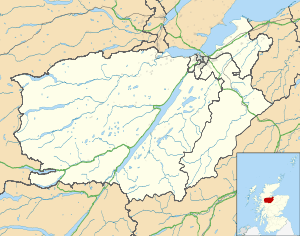Cawdor
Cawdor
| |
|---|---|
 Cawdor Cawdor shown within the Inverness area | |
| OS grid reference | NH846486 |
| Council area | |
| Country | Scotland |
| Sovereign state | United Kingdom |
| Post town | Nairn |
| Postcode district | IV12 5 |
| Police | Scottish |
| Fire | Scottish |
| Ambulance | Scottish |
| EU Parliament | Scotland |
| UK Parliament | |
| Scottish Parliament | |
Cawdor (Scottish Gaelic: Caladar) is a village and parish in the Highland council area, Scotland.[1] The village is situated 5 miles south south west of Nairn, and 12 miles east from Inverness. The village is in the Historic County of Nairnshire.
History
The village is the location of Cawdor Castle, the seat of the Earl Cawdor.
Macbeth, in Shakespeare's play of the same name, becomes Thane of Cawdor early in the narrative.[1] However, since the oldest part of the structure dates from the 14th century, and has no predecessor , Shakespeare's version (and the tradition which came before it) is of extremely dubious historical authenticity.
The name "Cawdor" is the English pronunciation and spelling of the ancient and original name Calder. In the early 19th century, the Lord at the time was residing in England and changed the name of the castle, town and clan overnight so that it would match the Shakespearian designation.
Roman fort
In 1984, a strong candidate for a Roman fort was identified at Easter Galcantray, south west of Cawdor, by aerial photography.
The site was excavated between 1985 and 1988 and several features were identified which are of this classification.
A single fragment of Roman coarse ware was found in the bottom of the ditch outside the south-west gateway along with burnt material; this pottery has very similar fabric to that found at Inchtuthill. In addition to this sparse pottery evidence, the demolition deposits in the western ditch yielded a piece of charcoal which has been radiocarbon dated to A.D. 80-130 (Calibrated).
The radiocarbon test gave a possible date of construction during Agricola campaign.[2]
Local community
The area has recently received a new school building as the old school was over one hundred years old and could not fit all of the pupils and had been using huts (pre-fabricated caravan-like structures) to make room. The area also has a very well stocked (and licensed) village shop which provides a vital service for the local community.
See also
Notes
- 1 2 "Cawdor". The Gazetteer for Scotland. School of GeoSciences, University of Edinburgh and The Royal Scottish Geographical Society. Retrieved 17 June 2018.
- ↑ Excavations at Cawdor 1986
References

| Wikimedia Commons has media related to Cawdor. |